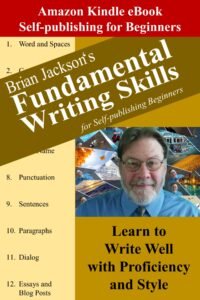In this section, I address the most important thing you can do to improve customer reviews and book sales; namely, copy editing your own book to remove common spelling, word usage and grammar errors. Along the way, I explain the difference between copy editing and content editing, advocate for self-editing your book and conclude with a process for copy editing your own book.
Note: The following is an excerpt from Amazon Kindle eBook Marketing and Promotion for Self-publishing Beginners.
Copy Editing vs Content Editing
Before discussing copy editing in detail, I want to begin by distinguishing copy editing from content editing – the other common form of book editing.
Copy editing involves reviewing a manuscript for common spelling, word usage and grammar errors. Professional copy editors typically include fact-checking with their services. Copy editing must be performed on your manuscript if you are to avoid receiving bad reader reviews resulting in lost revenue.
Content editing involves reviewing a manuscript for such things as plotting, character development, writing style and world-building. Content editing involves what the story is about rather than how it’s implemented. Content editing remarks can be obtained via writing groups and can’t be avoided if you have a publisher.
While copy editing is a must, I find that content editing comments are not useful to me. You may feel differently and therefore pursue obtaining content editing input. Regardless, you must copy edit your book before self-publishing it.
Cost of Not Copy Editing Your Book
The first book I published that was written by my wife, Moving Violation, was not copy edited. Melanie and I did our best to copy edit the book ourselves but ended up doing a poor job. As a result, the book received poor reviews on Amazon, and sales suffered. To this day, the book is rated at 3.5 stars on Amazon. Later, we hired a professional copy editor to scrub the book; but by then, the damage was done.
The number one thing that you can do to market your book is to copy edit it.
Cost of Professional Copy Editing Services
Hiring a professional copy editor is the best way to produce optimal copy editing results. The problem is that professional copy editing services can cost somewhere in the range of $300 to $500, depending on book-length. That’s a lot of money to have to recoup before making a profit on your book.
In the following section, I outline a process for avoiding professional copy editing expenses by copy editing your own book.
Copy Editing Your Own Book
Your manuscript must be copy edited. However, professional copy editing services are way too expensive for the average indie author. As a result, I recommend copy editing your own book. This is what I’ve done with this book and what I currently do with everything I write. To ensure the quality of my work, I employ the following copy editing process.
Step 1: Use Microsoft Word’s Built-in Error Checking
Microsoft Word provides built-in error checking to identify word misspellings and common grammar errors. As you type, Word will underscore misspelled words with a read line and grammar errors with either a blue or green underscore. Check out these error indicators as they’re presented, paying particular attention to the red underscores.
An additional feature of Microsoft Word is the ability to display synonyms for any word in your manuscript. Simply right-click on a word and select Synonyms from the pop-up menu to display words that mean the same thing as the selected word. Use this feature to replace word repetitions and spice up your vocabulary. This is the first step to copy editing your own book.
Step 2: Use Grammarly to Check for Common Spelling and Grammar Errors
Although my preferred document editor, Microsoft Word, provides spelling and grammar checking, I find its grammar checking, in particular, to be limited. As a result, I run a Microsoft Word plugin named Grammarly to find additional grammar errors.
Grammarly comes in a free version and an enhanced paid version. I found no great benefit to running the paid version. So, I recommend that you acquire the free version of Grammarly and either use it standalone to check your manuscript or use it as a Microsoft Word plugin.
Note that Grammarly also checks for word repetition, another reader annoyance that should be addressed during copyediting.
Once you complete running Grammarly against your manuscript and address all suggestions, your book should be spelling and grammar error free. The remaining manual copy editing steps should focus on finding sentences that don’t make sense. For example:
Dogs love to eat rocks.
This sentence is spelling and grammar error free but is still in error.
Get your copy of Grammarly at https://www.grammarly.com.
Step 3: Copy Edit Your Manuscript Backward
One of the problems the people run into while copy editing your own book is getting involved in the story while reading instead of looking for copy editing errors. To avoid this trap, I recommend that you copy edit your manuscript backward from the end to the beginning. Simply back up and edit one or two paragraphs at a time. In this way, you’ll avoid getting drawn into your story and remain focused on your objective: finding sentences that either don’t make sense or don’t say what you meant to say.
Step 4: Read Your Manuscript Out Loud During Copy Editing
Another technique for finding even more errors is to read your manuscript out loud while copy editing. The translation of your words into speech allows you to hear the word usage and phrasing errors in your work.
Step 5: Draft Friends, Family and Peers to Review Your Manuscript
I typically find that the above steps are sufficient to catch the majority of the errors in my manuscripts. However, there will always be errors left behind. One way to catch these missed errors is to draft as many eyes (people) as you can to read your manuscript. Others will undoubtedly find things you missed.
I recommend that as a final editing step, you draft friends, family and fellow writers (perhaps from a writing group) to review your manuscript. It’s up to you as to what you do with the inevitable content editing comments.
This has been a summary of copy editing your own book to perfection.
I’ll see you in the classroom,
—Brian


















